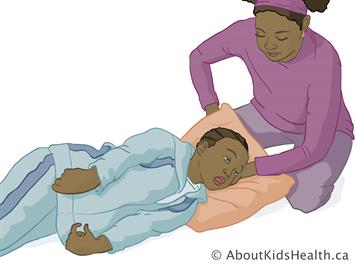What To Do If Your Child Has a Fit Or Convulsion

If your child has a fit or a convulsion, they may suddenly become rigid, with staring eyes. Sometimes their eyes will roll and their limbs will twitch and jerk. Or they may suddenly go floppy. The following suggestions will help you deal with the fit:
- Keep calm.
- Lie your child on their side to make sure they don’t vomit or choke. Don’t put anything in their mouth. If you think they’re choking on food or an object, try to remove it.
- Remove your child’s clothing and any coverings and make sure they’re cool but not chilly.
- Most fits will stop within three minutes. When it’s over, reassure your child, make them comfortable and call a doctor.
- If the fit hasn’t stopped within three minutes, call 999. If it stops but it was your child’s first fit, take them to the nearest accident and emergency department to be checked over.
- Don’t panic. Fits need to last longer than 30 minutes for there to be any risk of brain damage.
- Even if it’s not the first time and your child recovers quickly, let your GP know that your child has had a fit.
READ ALSO: Trying For a Baby After a Miscarriage? See What You Must Do After Your Loss
Although fits may look alarming, they’re common in children under the age of three. Although there are other reasons why children have a fit, a high temperature is the most common trigger. Therefore, ensure to keep your child’s fever down by offering paracetamol.
Fever fits, also known as febrile convulsions, become increasingly less common after the age of three and are almost unknown after the age of five. Febrile convulsions aren’t usually connected with epilepsy. Read more about febrile convulsions.



Tanks so much for dis
Thanks MIsM
Thanks MISM
Leanrin so much here. Tanks MIM
911 calls is not for this part of the world, thanks for the tips though. Our country emergency system is on the zero level, it’s a huge shame.
Very good info
Thanks MIM…
Sandra Ekwealor
Nkpuluma we have our own emergency system,
If you call 911 or 112 it would lead to same helpline
Tnx admin
Thank you so much
It must be really scary
Thanks
Thanks MISM
WAO thanks
tnks
Thanx
Thanks even though no 911 here.
Tnx MISM
Great, tnks
Great info. Thanks admin
Tnx MISM
Great..
Thanks
Helpful much!!!!Thnx
Message..gud tips
Nice info tnx
TKS
Thank you for this information.
Thanks
Good information…
tanx for this
Thanks
Noted
Great info.. Thanks MIM.
My daughter kept having febrile convulsions from 3months. It kept coming once she has fever. She’s 3yrs now and thank God for almost sis months now. It stopped.